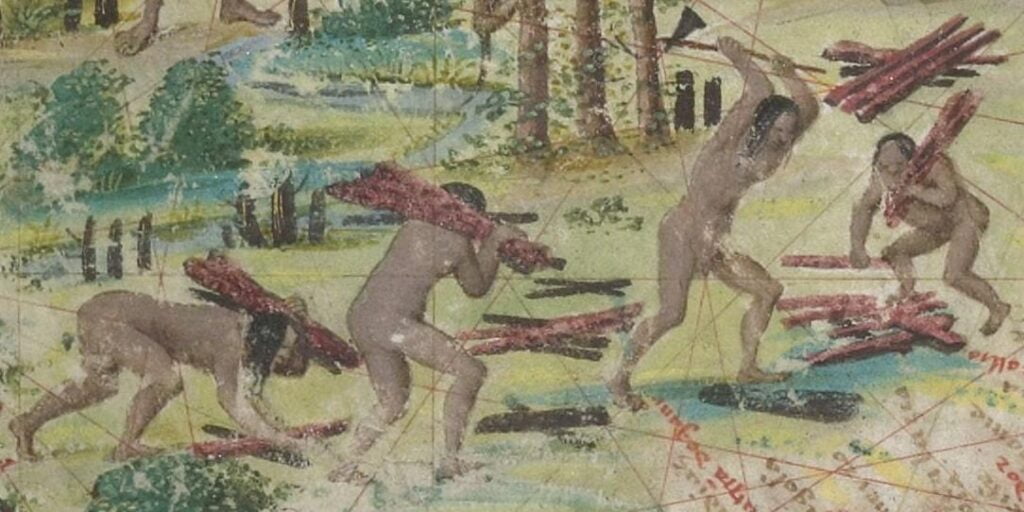Table of Contents
1. Introduction
2. The arrival of the Portuguese in Brazil
– Discovery of Brazil by Pedro Álvares Cabral
– The exploitation of brazilwood by the Portuguese
3. The Brazilwood cycle in colonial Brazil
– Extraction of Brazilwood and indigenous slavery
– Brazilwood trade and European rivalries
4. Consequences of colonization and exploitation of pau-brasil
– Environmental impact and indigenous displacement
– Establishment of the Portuguese colonial system
5. Conclusion
– Historical importance of Brazilwood in Brazilian colonization
6. FAQs
7. References
Introduction
The colonization and exploitation of Brazilwood played a fundamental role in the history of colonial Brazil. In this article, we will explore how the Portuguese arrived in Brazil, the exploitation of this natural resource and the consequences of this activity for the country. Let’s delve into the fascinating history of Brazilwood colonization and exploration.
The arrival of the Portuguese in Brazil
“Discovery” of Brazil by Pedro Álvares Cabral
In April 1500, Portuguese explorer Pedro Álvares Cabral arrived in the lands that would later be called Brazil. He was on a mission to establish trade routes with the Indies, but ended up discovering this vast unknown territory. This discovery marked the beginning of Portuguese colonization in the region.
The exploitation of brazilwood by the Portuguese
Soon after the discovery of Brazil, the Portuguese realized the enormous economic potential of the newly discovered lands. However, Brazilwood was the main motivation for initial colonization. This reddish wood tree was highly valued in Europe for its color and quality in the production of paints, and the Portuguese saw a great opportunity for profit in exploiting this natural resource.
The Brazilwood cycle in colonial Brazil
Brazilwood extraction and indigenous slavery
Brazilwood extraction involved felling the trees and cutting off their bark, which was then exported to Europe. To facilitate this activity, the Portuguese counted on the help of local indigenous people, who were enslaved and forced to carry out this strenuous task. This was one of the first examples of the exploitation of the native peoples of Brazil by European colonizers.
Brazilwood trade and European rivalries
The Brazilwood trade was extremely profitable for Portugal, which had a monopoly on this activity. However, other European powers, such as France and the Netherlands, saw the opportunity to obtain a share of this valuable market. This led to conflicts and rivalries between European nations, resulting in several territorial disputes along the Brazilian coast.
Consequences of colonization and exploitation of pau-brasil
Environmental impact and indigenous displacement
The rampant exploitation of brazilwood has had a devastating impact on the environment. The indiscriminate felling of trees has led to the deforestation of large areas and the loss of habitat for several species. Furthermore, the indigenous people who previously lived in these regions were expelled from their lands and suffered a process of forced displacement, which resulted in cultural and demographic loss.
Establishment of the Portuguese colonial system
The exploitation of Brazilwood was one of the first steps towards the establishment of the Portuguese colonial system in Brazil. Based on this initial success, the Portuguese expanded their presence in the territory and established sugar cane plantations, mills and other economic activities. This colonial system had a lasting impact on Brazilian society and shaped its future history.
Conclusion
The colonization and exploitation of Brazilwood played a fundamental role in the formation of colonial Brazil. The discovery of this valuable natural resource by the Portuguese paved the way for colonization and the establishment of colonies in the region. Despite the negative consequences, it is important to recognize the historical importance of Brazilwood for the development of Brazil as a nation.
FAQs
1. What was the economic importance of brazilwood?
– Brazilwood was highly valued in Europe for its color and quality in the production of paints, which made it an extremely profitable natural resource.
2. How were indigenous people involved in the exploitation of brazilwood?
– The indigenous people were enslaved by the Portuguese and forced to cut the bark of Brazilwood in the extraction areas.
3. What were the environmental consequences of the exploitation of brazilwood?
– Deforestation resulting from the rampant extraction of Brazilwood has had a devastating impact on the environment, resulting in the loss of habitat and a decrease in biodiversity.
4. Why did other European powers compete with Portugal in the Brazilwood trade?
– The Brazilwood trade was extremely profitable, which led other European nations, such as France and the Netherlands, to try to obtain a share of this valuable market.
5. How did the exploitation of Brazilwood contribute to the establishment of the Portuguese colonial system in Brazil?
– The initial success of Brazilwood exploration paved the way for the Portuguese to expand their presence in Brazil, establishing colonies and economic activities that shaped Brazilian society.
References
Wikipedia – Colonization of Brazil
